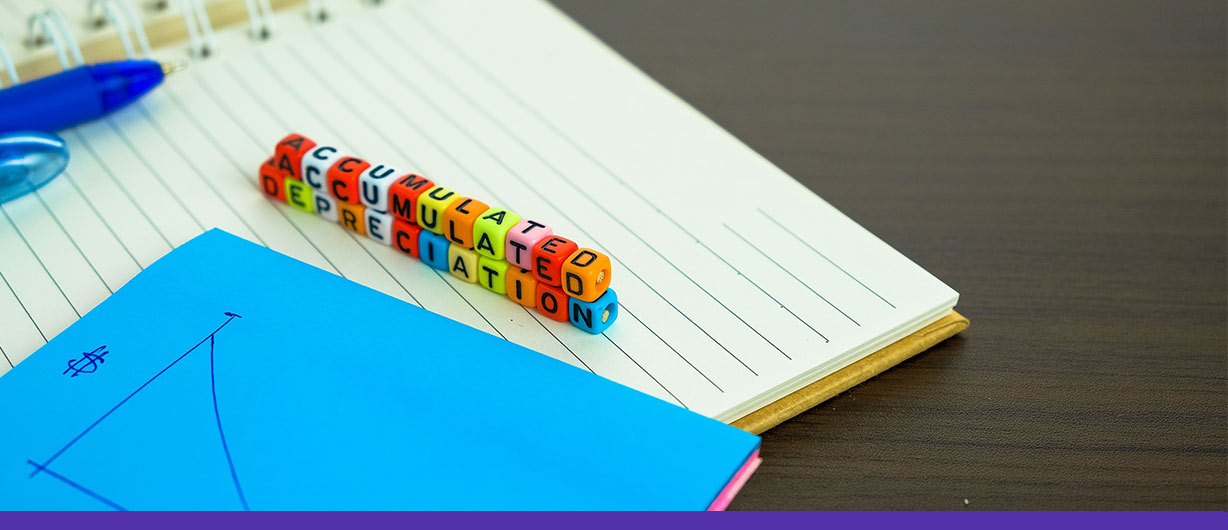May 31 2023 | By Wajiha Danish | 5 minutes Read

What Is Accumulated Depreciation?
What is depreciation expense?
What is accumulated depreciation calculation?
Step 1: Determine the asset’s cost
Step 2: Determine the asset’s useful life
Step 3: Determine the asset’s salvage value
Step 4: Calculate the depreciation expense
Step 5: Calculate the accumulated depreciation
Here’s an example:
Is accumulated depreciation an asset?
Is accumulated depreciation a debit or credit?
Conclusion
If you own a business, keeping track of your assets is crucial to your financial well-being. One important aspect of asset management is understanding accumulated depreciation and how it affects your balance sheet.
So, what exactly is accumulated depreciation? In short, it’s the total depreciation expense charged to an asset since it was acquired and put into service. Depreciation is the gradual decrease in the value of an asset over time due to wear and tear, obsolescence, or other factors. It’s important to note that accumulated depreciation is a contra-asset account, which means that it reduces the asset’s carrying value on the balance sheet and reflects the asset’s reduced value due to depreciation.
Depreciation expenses refer to allocating the cost of a long-term asset over its useful life. It is an accounting method used to spread out the cost of a fixed asset over the period during which it is expected to provide economic benefits.
When a company purchases a long-term asset such as a building, vehicle, or equipment, it records its cost on its balance sheet. However, as the asset is used over time, it loses value or becomes obsolete. Depreciation expenses are the portion of the asset’s cost expensed yearly to reflect it is decreasing value or usefulness.
Depreciation expenses are recorded on the company’s income statement as non-cash expenses, reducing the company’s taxable income. It can provide tax benefits for the company but also reduce its net income, affecting its profitability and financial position.
Accumulated depreciation is the total depreciation charged on a fixed asset since it was acquired. It is an important concept in accounting as it reduces the asset’s value on the balance sheet and reflects its diminishing value over time. Here’s how to calculate accumulated depreciation step by step:
The asset’s cost is the amount paid to acquire it, including any additional expenses incurred to get it ready for use, such as installation costs, shipping fees, etc.
Useful life refers to the period during which the asset is expected to generate revenue or be useful to the business. Business usually estimates this period and can be based on factors such as wear and tear, technological obsolescence, or legal limitations.
Salvage value is the estimated amount the asset can be sold for at the end of its useful life. It is also called the residual value.
The depreciation expense is the amount of the asset’s cost allocated to each accounting period during its useful life. Different methods to calculate depreciation expense include straight-line depreciation, declining balance depreciation, or units-of-production depreciation. For this example, we will use the straight-line method, which is the simplest and most common.
The formula for straight-line depreciation is:
Depreciation Expense = (Cost – Salvage Value) / Useful Life
The accumulated depreciation is the sum of all depreciation expenses charged to the asset since it was acquired. To calculate it, you add the depreciation expenses for each period.
Suppose a company purchases a delivery truck for $50,000. The truck’s useful life is estimated to be five years, and its salvage value is $5,000. The company decides to use the straight-line method to calculate depreciation.
Depreciation Expense = ($50,000 – $5,000) / 5 = $9,000 per year
In the first year, the company would record a depreciation expense of $9,000 and an accumulated depreciation of $9,000. In the second year, the company would record another depreciation expense of $9,000 and add it to the previous year’s accumulated depreciation of $9,000, resulting in a total depreciation of $18,000. This process continues until the asset’s useful life ends or the asset is sold or disposed of.
Accumulated depreciation is not considered an asset, but a contra-asset account subtracted from the corresponding asset account on the balance sheet.
Accumulated depreciation represents the total depreciation recognized for a particular asset over its useful life. This amount is accumulated over time and is used to reduce the asset’s carrying value on the balance sheet.
While accumulated depreciation is not considered an asset, it is an important component of the overall value of the related asset. By subtracting accumulated depreciation from the asset’s original cost, the asset’s net book value or carrying value is determined.
Accumulated depreciation is a credit balance account.
It is a contra-asset account used to record an asset’s cumulative depreciation over its useful life. As the asset is depreciated over time, the balance in the accumulated depreciation account increases. This balance is then subtracted from the asset’s original cost to determine its net book value.
Since it is a contra-asset account, it has a credit balance because it reduces the value of the asset account, which has a debit balance.
In conclusion, accumulated depreciation is an accounting term that refers to the cumulative depreciation of an asset over its useful life. It is important for businesses to understand as it affects the balance sheet and can impact financial statements. Depreciation allows for the allocation of the cost of an asset over its useful life, thereby reducing the asset’s value on the balance sheet. This reduction in value can have tax benefits for businesses, but it also means that the asset may need to be replaced or upgraded. Understanding accumulated depreciation is crucial for businesses to make informed financial decisions and maintain accurate records.
Also Read: A Simple Guide To Double Declining Balance Depreciation Method
Subscribe for business tips, tax updates, financial fundamentals and more.
MORE BLOGS

If you’re a small business, we will absolutely get it if you say you’re having a hard time choosing a payment platform for your company. And […]
Learn More →
When it comes to accounting, businesses often face a confusing question: which accounting method should we adopt? The choice typically boils down to the cash basis […]
Learn More →
Driving for Uber or delivering with Uber Eats can be a flexible and rewarding way to earn money. But when tax season rolls around, many drivers […]
Learn More →